最新小学英语绘本阅读课 My gradma goes to school精品公开教学设计教案
- 格式:docx
- 大小:22.36 KB
- 文档页数:7

小学英语教育教学教案设计(精选9篇)(经典版)编制人:__________________审核人:__________________审批人:__________________编制单位:__________________编制时间:____年____月____日序言下载提示:该文档是本店铺精心编制而成的,希望大家下载后,能够帮助大家解决实际问题。
文档下载后可定制修改,请根据实际需要进行调整和使用,谢谢!并且,本店铺为大家提供各种类型的经典范文,如总结报告、心得体会、应急预案、会议记录、条据书信、合同协议、规章制度、教学资料、作文大全、其他范文等等,想了解不同范文格式和写法,敬请关注!Download tips: This document is carefully compiled by this editor. I hope that after you download it, it can help you solve practical problems. The document can be customized and modified after downloading, please adjust and use it according to actual needs, thank you!Moreover, our store provides various types of classic sample essays, such as summary reports, insights, emergency plans, meeting minutes, evidence letters, contract agreements, rules and regulations, teaching materials, essay summaries, and other sample essays. If you would like to learn about different sample formats and writing methods, please pay attention!小学英语教育教学教案设计(精选9篇)小学英语教育教学教案设计(精选9篇)2024-04-14 12:07:23小学英语教学设计(精选6篇)推荐度:小学英语教学设计范文最新6篇推荐度:热点范文英语(英文:English)是一种西日耳曼语支,最早被中世纪的英国使用,并因其广阔的殖民地而成为世界使用面积最广的语言。
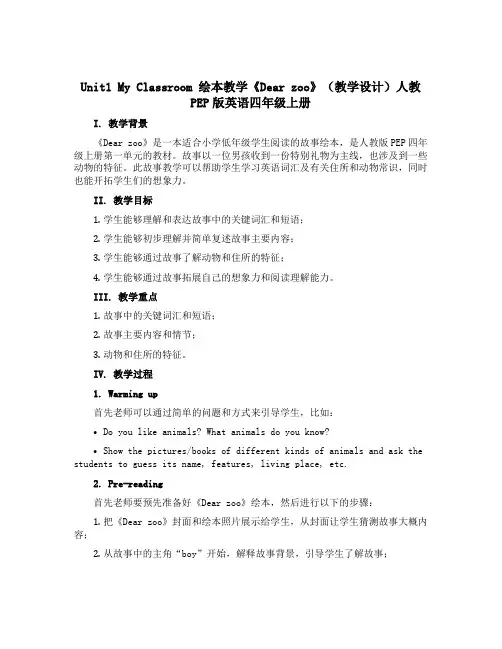
Unit1 My Classroom 绘本教学《Dear zoo》(教学设计)人教PEP版英语四年级上册I. 教学背景《Dear zoo》是一本适合小学低年级学生阅读的故事绘本,是人教版PEP四年级上册第一单元的教材。
故事以一位男孩收到一份特别礼物为主线,也涉及到一些动物的特征。
此故事教学可以帮助学生学习英语词汇及有关住所和动物常识,同时也能开拓学生们的想象力。
II. 教学目标1.学生能够理解和表达故事中的关键词汇和短语;2.学生能够初步理解并简单复述故事主要内容;3.学生能够通过故事了解动物和住所的特征;4.学生能够通过故事拓展自己的想象力和阅读理解能力。
III. 教学重点1.故事中的关键词汇和短语;2.故事主要内容和情节;3.动物和住所的特征。
IV. 教学过程1. Warming up首先老师可以通过简单的问题和方式来引导学生,比如:•Do you like animals? What animals do you know?•Show the pictures/books of different kinds of animals and ask the students to guess its name, features, living place, etc.2. Pre-reading首先老师要预先准备好《Dear zoo》绘本,然后进行以下的步骤:1.把《Dear zoo》封面和绘本照片展示给学生,从封面让学生猜测故事大概内容;2.从故事中的主角“boy”开始,解释故事背景,引导学生了解故事;3.给学生展示故事重点词汇(例如zoo、elephant、giraffe、frog、蟒蛇),让学生自己阅读、发音和模仿。
3. While-reading在进行阅读的时候,老师最好先模仿一遍,再让学生跟读、模仿,之后再分步骤进行讲解和操练。
操练方式可以有:1.让学生根据绘本内容和老师所描述的细节,猜测故事;2.播放与故事相关的课件/视频/音频,让学生通过语音和图片进行理解和梳理,加深印象;3.回答问题:例如故事中出现的每个动物长什么样子?它们放在哪里?它们最后为什么不符合boy的要求?4.分小组进行阅读,每个小组或个人主要讲述故事中的哪一部分内容。

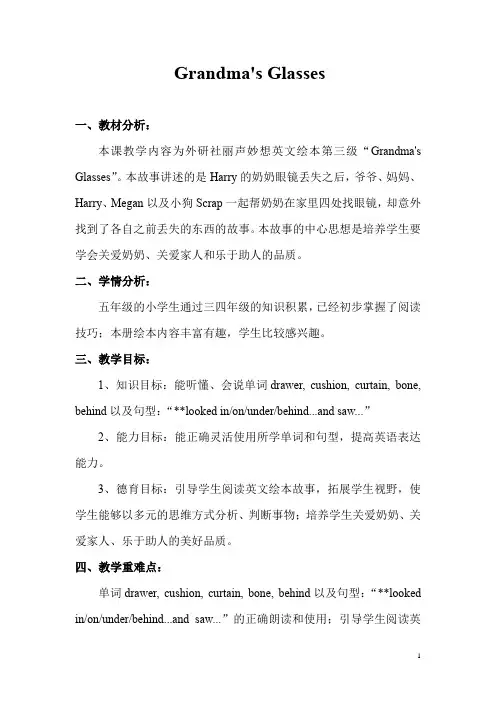
Grandma's Glasses一、教材分析:本课教学内容为外研社丽声妙想英文绘本第三级“Grandma's Glasses”。
本故事讲述的是Harry的奶奶眼镜丢失之后,爷爷、妈妈、Harry、Megan以及小狗Scrap一起帮奶奶在家里四处找眼镜,却意外找到了各自之前丢失的东西的故事。
本故事的中心思想是培养学生要学会关爱奶奶、关爱家人和乐于助人的品质。
二、学情分析:五年级的小学生通过三四年级的知识积累,已经初步掌握了阅读技巧;本册绘本内容丰富有趣,学生比较感兴趣。
三、教学目标:1、知识目标:能听懂、会说单词drawer, cushion, curtain, bone, behind以及句型:“**looked in/on/under/behind...and saw...”2、能力目标:能正确灵活使用所学单词和句型,提高英语表达能力。
3、德育目标:引导学生阅读英文绘本故事,拓展学生视野,使学生能够以多元的思维方式分析、判断事物;培养学生关爱奶奶、关爱家人、乐于助人的美好品质。
四、教学重难点:单词drawer, cushion, curtain, bone, behind以及句型:“**looked in/on/under/behind...and saw...”的正确朗读和使用;引导学生阅读英文绘本故事,拓展学生视野,使学生能够以多元的思维方式分析、判断事物;培养学生关爱奶奶、关爱家人、乐于助人的美好品质。
五、教学准备:课件、单词卡等。
六、教学过程:Step1 Warming-up1. A song<In ,on ,under>.2. Play a game: "I SAY ,YOU DO."【设计意图】用儿歌复习方位介词和有关“方位”的游戏,既可以为学习本课内容做铺垫,又可以调动学生的学习积极性。
Step2 Presentation1. Pre-readingWhat is the story about ? <Grandma’s glasses>Introduce the writer and illustrator of the picture book.【设计意图】阅读文本之前,让生观察封面图片,了解绘本大意及作者简介,引入主题。
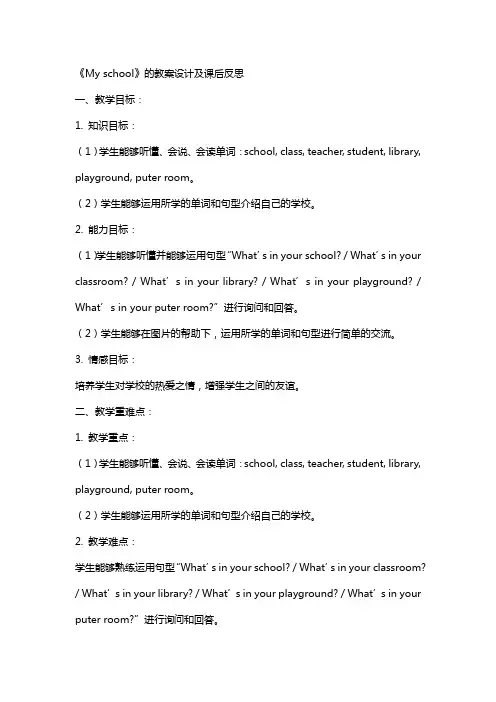
《My school》的教案设计及课后反思一、教学目标:1. 知识目标:(1)学生能够听懂、会说、会读单词:school, class, teacher, student, library, playground, puter room。
(2)学生能够运用所学的单词和句型介绍自己的学校。
2. 能力目标:(1)学生能够听懂并能够运用句型“What’s in your school? / What’s in your classroom? / What’s in your library? / What’s in your playground? / What’s in your puter room?”进行询问和回答。
(2)学生能够在图片的帮助下,运用所学的单词和句型进行简单的交流。
3. 情感目标:培养学生对学校的热爱之情,增强学生之间的友谊。
二、教学重难点:1. 教学重点:(1)学生能够听懂、会说、会读单词:school, class, teacher, student, library, playground, puter room。
(2)学生能够运用所学的单词和句型介绍自己的学校。
2. 教学难点:学生能够熟练运用句型“What’s in your school? / What’s in your classroom? / What’s in your library? / What’s in your playground? / What’s in your puter room?”进行询问和回答。
三、教学方法:1. 情境教学法:通过创设情境,让学生在真实的环境中学习英语,提高学生的学习兴趣。
2. 交际法:通过学生之间的互动,培养学生的交际能力。
3. 任务型教学法:通过完成任务,让学生在实践中学习英语。
四、课前准备:1. 单词卡片:school, class, teacher, student, library, playground, puter room。
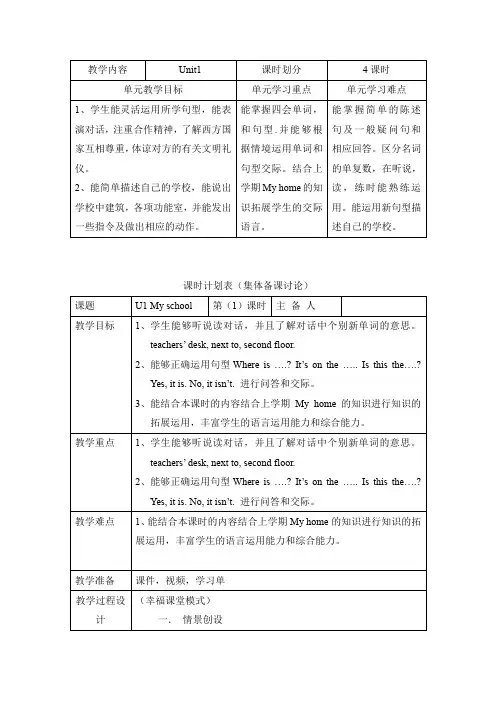

小学英语教案Unit Lets go to school!(最新版)编制人:__________________审核人:__________________审批人:__________________编制单位:__________________编制时间:____年____月____日序言下载提示:该文档是本店铺精心编制而成的,希望大家下载后,能够帮助大家解决实际问题。
文档下载后可定制修改,请根据实际需要进行调整和使用,谢谢!并且,本店铺为大家提供各种类型的实用范文,如教案大全、公务礼仪、合同协议、总结报告、工作计划、工作材料、演讲致辞、规章制度、条据书信、其他范文等等,想了解不同范文格式和写法,敬请关注!Download tips: This document is carefully compiled by this editor.I hope that after you download it, it can help you solve practical problems. The document can be customized and modified after downloading, please adjust and use it according to actual needs, thank you!In addition, this shop provides you with various types of practical sample essays, such as teaching plans, official etiquette, contract agreements, summary reports, work plans, work materials, speeches, rules and regulations, letter of agreement, other sample essays, etc. I want to know Different format and writing styles of sample essays, so stay tuned!小学英语教案Unit Lets go to school!小学英语教案一、教学目标与要求1.能听懂、会说:---Ihaveanewpencil-box.---Whatsinit?---Look.---Oh,amarkerandsomecrayon.并能在实际生活中运用。

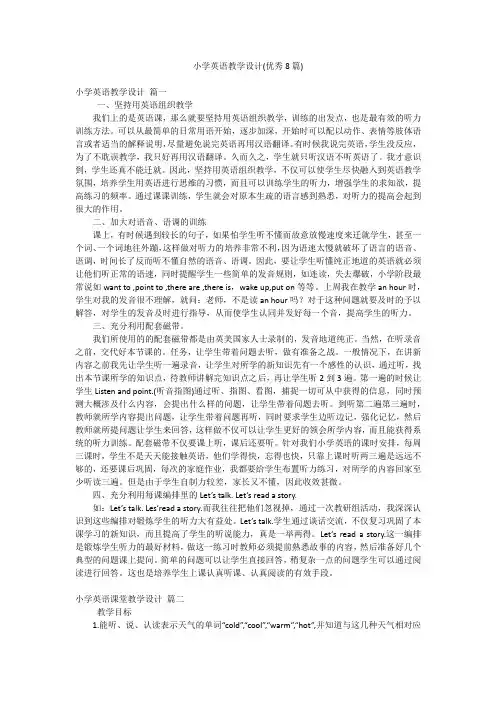
小学英语教学设计(优秀8篇)小学英语教学设计篇一一、坚持用英语组织教学我们上的是英语课,那么就要坚持用英语组织教学,训练的出发点,也是最有效的听力训练方法。
可以从最简单的日常用语开始,逐步加深,开始时可以配以动作、表情等肢体语言或者适当的解释说明,尽量避免说完英语再用汉语翻译。
有时候我说完英语,学生没反应,为了不耽误教学,我只好再用汉语翻译。
久而久之,学生就只听汉语不听英语了。
我才意识到,学生还真不能迁就。
因此,坚持用英语组织教学,不仅可以使学生尽快融入到英语教学氛围,培养学生用英语进行思维的习惯,而且可以训练学生的听力,增强学生的求知欲,提高练习的频率。
通过课课训练,学生就会对原本生疏的语言感到熟悉,对听力的提高会起到很大的作用。
二、加大对语音、语调的训练课上,有时候遇到较长的句子,如果怕学生听不懂而故意放慢速度来迁就学生,甚至一个词、一个词地往外蹦,这样做对听力的培养非常不利,因为语速太慢就破坏了语言的语音、语调,时间长了反而听不懂自然的语音、语调。
因此,要让学生听懂纯正地道的英语就必须让他们听正常的语速,同时提醒学生一些简单的发音规则,如连读,失去爆破,小学阶段最常说如want to ,point to ,there are ,there is,wake up,put on等等。
上周我在教学an hour时,学生对我的发音很不理解,就问:老师,不是读an hour吗?对于这种问题就要及时的予以解答,对学生的发音及时进行指导,从而使学生认同并发好每一个音,提高学生的听力。
三、充分利用配套磁带。
我们所使用的的配套磁带都是由英美国家人士录制的,发音地道纯正。
当然,在听录音之前,交代好本节课的。
任务,让学生带着问题去听,做有准备之战。
一般情况下,在讲新内容之前我先让学生听一遍录音,让学生对所学的新知识先有一个感性的认识,通过听,找出本节课所学的知识点,待教师讲解完知识点之后,再让学生听2到3遍。
第一遍的时候让学生Listen and point.(听音指图)通过听、指图、看图,捕捉一切可从中获得的信息,同时预测大概涉及什么内容,会提出什么样的问题,让学生带着问题去听。
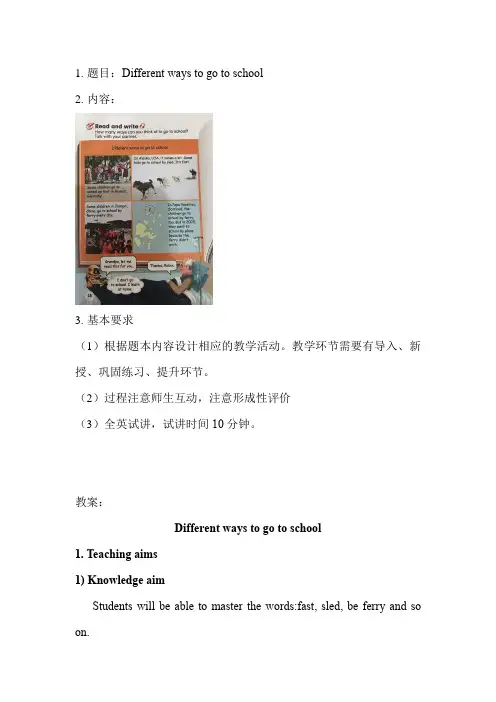
1.题目:Different ways to go to school2.内容:3.基本要求(1)根据题本内容设计相应的教学活动。
教学环节需要有导入、新授、巩固练习、提升环节。
(2)过程注意师生互动,注意形成性评价(3)全英试讲,试讲时间10分钟。
教案:Different ways to go to school1. Teaching aims1) Knowledge aimStudents will be able to master the words:fast, sled, be ferry and so on.Students will be able to get the meaning:“Some kids go to school by sled.”2) Ability aimStudents can train their reading skills by reading to the key words and understand different countries have different ways to go to school.3) Emotional aimStudents can realize their own ways to go to school by cosidering many elements.2. Important and difficult points1) Important pointStudents will be guided to master many ways and countries in English.2) Difficult pointStudents will improve their reading skills as well as the ability to use the new words and sentences to communicate freely.3. Teaching and learning methodsSituational teaching method; communicative teaching method; task-based teaching method;group work method; cooperation study method; independent study method4. Teaching proceduresStep 1: Lead inSing a songI will present some pictures with music to help them review the words they learned before. Such as: by bus,by car, on foot, traffic lights...Step 2: Pre-readingShowing pictures. Talk about the picture of“Robin and grandpa ”they will answer many questions as follows:Q1:Who is he ?How is he?Q2:What does Robin want to do ? Q3:What’s the text about ? That’s our topic today:Different ways to go to schoolStep3 while-readingFirst reading:Find the key words.Q1:How many countries can you find ? They are ....Learn the new/key words T: I have so many beautiful pictures about these countries .Now let’s learn the new words about it .The second reading :Read the text quickly and underline the places to go to school with “__”,the ways with “ ___ ” Q1.T: How many ways to go to school? Can you find ?Present the main text.Travel the four places one by one. Q2: Does everyone go to school? Why?The third time, reading and listening.Step 4: post-reading1.Listen and imitate.(work in groups)2.report3.Writing (fill in the blanks)Step5 Summary1)Different places have different ways to go to school2)We should enjoy our own ways to school ;enjoy our beautiful life .Step6 Homework(1) Retell the text.and know the meaning.(2)Tell your parents what we have learned before.Step 7 Blackboard designDifferent ways to go to schoolMunick Germany on foot G1 G2Alaska USA sledJiangxi China by ferryPapa Westray Scotland by ferry /by plane试讲稿:Different ways to go to school1.Greeting and warming upGood morning, guys! How are you today?You are fine? You are ok? You are just so so? Ok, I’m so glad to be here! What’s the weather like today? Is it cold? Ok, show me your hands ! let’s sing a song and have a relax. Let’s go. Oh, you like it. Most of you are interested in it.2. Pre-readingOK, now boys and girls,Tomorrow is Sunday, do you want to have a trip? Today we’ll travel around the world. Look at the picture .Where is。
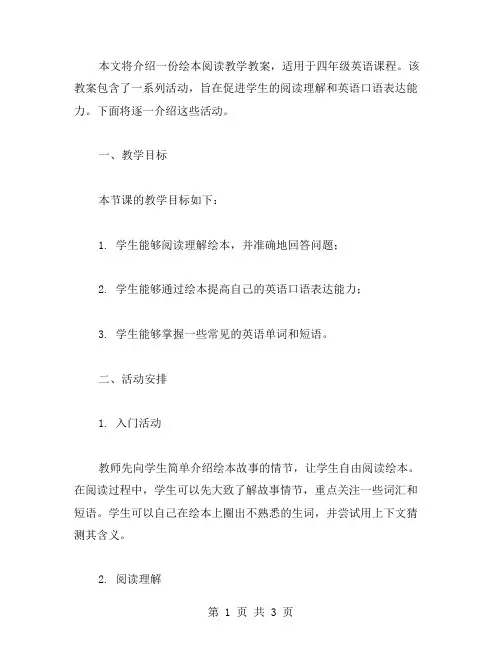
本文将介绍一份绘本阅读教学教案,适用于四年级英语课程。
该教案包含了一系列活动,旨在促进学生的阅读理解和英语口语表达能力。
下面将逐一介绍这些活动。
一、教学目标本节课的教学目标如下:1. 学生能够阅读理解绘本,并准确地回答问题;2. 学生能够通过绘本提高自己的英语口语表达能力;3. 学生能够掌握一些常见的英语单词和短语。
二、活动安排1. 入门活动教师先向学生简单介绍绘本故事的情节,让学生自由阅读绘本。
在阅读过程中,学生可以先大致了解故事情节,重点关注一些词汇和短语。
学生可以自己在绘本上圈出不熟悉的生词,并尝试用上下文猜测其含义。
2. 阅读理解教师可以在黑板上列出一些问题,让学生回答有关故事的细节,例如:a. Who is the main character of the story?b. What is the main character’s goal in the story?c. How does the main character achieve his/her goal?d. What is the moral of the story?通过这些问题,学生不仅能够加深对故事情节的理解,还能够开展口语表达,增强英语口语表达能力。
3. 分角色朗读教师可以把学生分为小组,每组选择一个角色,并读出该角色所说的台词。
通过这种方式,学生可以更好地理解故事情节,并体验角色的感情和语气。
4. 小组讨论教师可以把学生分成小组,在小组内讨论绘本中的问题。
学生可以在讨论中学习和分享他们的阅读理解和观点,这种活动可以促进学生的口语表达能力,并能培养他们的合作精神。
5. 词汇练习教师可以在黑板上列出一些生词和短语,并让学生在小组内进行词汇记忆练习。
教师可以通过这种方式来扩展学生的英语词汇量,并帮助他们熟练掌握常用的英语短语。
三、总结本节课教学教案主要是通过绘本阅读教学来促进学生的阅读理解和英语口语表达能力。
通过这样的教学方式,学生可以拓展自己的英语词汇量、提高阅读理解能力,并且能够更好地沟通交流。
小学英语绘本《Where is my mom?》教学设计教学目标本节课学习结束后,学生能够:1.利用上下文、图画、动作及已有知识经验等正确理解fly,beautiful,flower,tree,grass,ladybird,bee的意义,能够基本正确地跟读、指读、朗读故事;2.尝试运用一些基本的阅读策略如利用上下文线索词、插图中的信息以及已有的知识经验去预测、推理出毛毛虫与不同的动物之间的对话,能够借助板书对故事文本的主要线索进行梳理提炼;3.正确地用故事中的句式去猜测某人或某物的位置,并能够回答;4.要学习小毛毛虫在遇到自己无法解决的困难时,主动而且有礼貌的去寻求别人的帮助,在失败面前不气馁。
教学过程Step 1: Warm up 热身准备T: Let’s sing a beautiful song<Where is the bird?> Do you like it?S:Yes.设计意图:利用歌曲<Where is the bird?>让生感知句型,方位词及flower,tree,为故事阅读做铺垫。
T:Yes. I like it. It’s beautiful. Wow,so many animals. I see a lion. What do you see? S:...T: These animals are big. These animals are small.师做手势They will play a game hide and seek. Let’s play together, OK?S:..出示图片让生用句子Is it on/in/under...?来猜测,师示范Step2: Cover (title) talk & lead in the story 封面( 标题) 探讨Activity 1: Talk about the title and the cover.T: Oh, a little caterpillar. His name is Mike. He is a boy.T: I s he happy?师做动作帮住学生理解happyGuess why he is not happy? (S1: Maybe....)The title of the story is Where is my mom?Let’s read it together.揭示课题贴课题He can’t find his mom,so he is not happy.Step 3: Picture walk of the story 图片环游T: Mike is going to find his mom. Is this his mom?(出示小鸟的影像让生猜测)(Ss: No.) What is it? (Ss : …)T: What can the bird do? (Students predict.)师教授flyT: Mike’s mom also can fly. Mike says出示毛毛虫说的话Mymom can fly. Are you my mom?猜测小鸟的答语,并核对答案T: Do you know where is his mom? Can you guess? You canuse the sentence Is she on/in/under...猜测完了阅读寻找答案T: Mike doesn’t find his mom. So he go on to find hismom.Guess which animal will he meet?教授ladybirdW:My mom is beautiful.__________________?L: I’m not your mom. I’m a ___________.W: Oh,no! Where is my mom?L: Is she _____________?W: _________________.Try to fill in the blanks. Discuss in your groups. 2分钟时间讨论。
《Unit 1 Lets go to school!》教案(通用3篇)《Unit 1 Lets go to school!》篇1(人教新版)三年级英语下册教案unit 1 let’s go to school!lesson 3一、教学内容与分析:1. just speak通过两个学生之间的对话,让学生在具体语境中感知、模仿、学习、体验、实践本课语言。
要求学生能根据情景进行语言交流,最终能灵活使用本课句型look at.-how nice! what's in it及答语a marker and some crayons,同时培养学生团结友爱的好品质。
本部分的主要语言点是:1) look at….2)wow,how nice!3)what's in it ?2. just read学会两个新单词:marker,crayon教师应注意的难点是:1)英语中可数名词单数前面要用a/an。
2)教师可在适当时机复习pencil,ruler,eraser,sharpener等一册学过的学习用品。
同时练习名词的单复数,如:a pencil some pencils.3. let's play通过实物组织教学活动,让学生反复练习what's in the pencil-box ? what's in it及答语crayon/a pencil,以达到复习巩固本课教学内容的目的。
二、课前准备:1.准备—些水彩笔、小蜡笔或蜡笔画,奖励给课堂表现出色的学生。
2.准备教学挂图或实物:袋子、铅笔盒、水彩笔、蜡笔等,给学生创造真实情景让学生充分地练习。
3.准备本课教学—卡片、录音带等。
三、教学目标与要求:1.指导学生能在真实的情景中理解。
会说以下句子: let’s to go to school. let’s go, look. i have a new water bottle/story book. look at my new pencil-box. what’s in it?a marker and some crayons. what’s in my bag? what’s on the table? 并能在现实生活中灵活运用这些语言。
Unit2 My school(教学设计)-2023-2024人教版(新起点)英语三年级下册一、教学目标语言知识目标:学生能够听懂、会说、认读与学校设施相关的词汇,如classroom (教室)、library(图书馆)、playground(操场)、teachers' office (教师办公室)、computer room(计算机房)等。
学生不仅要准确掌握这些词汇的发音和拼写,还要理解其含义和在学校中的具体功能。
例如,“classroom”是学生上课的地方,里面有桌椅、黑板等设施;“library”是学生借阅书籍、阅读和学习的场所;“playground”是学生进行体育活动和玩耍的地方;“teachers' office”是教师办公的地方;“computer room”是学生上计算机课和使用电脑的房间。
学生可以通过观察图片、实地参观学校设施、观看视频等方式来加深对这些词汇的理解和记忆。
掌握句型“This is...(这是……)”“That is...(那是……)”“Where is...?(……在哪里?)”“It's...(它在……)”,并能在实际情境中准确运用。
学生要熟练掌握这四个句型的结构和用法,能够用正确的语法和语调来介绍学校设施和询问学校设施的位置。
例如,当介绍学校设施时,可以用“This is our classroom. It's very clean.”(这是我们的教室。
它很干净。
)或者“That is the library. It has many books.”(那是图书馆。
它有很多书。
)当询问学校设施的位置时,可以用“Where is the teachers' office?(教师办公室在哪里?)”然后回答“It's on the second floor.”(它在二楼。
)学生可以通过情景模拟、角色扮演、对话练习等方式来提高自己运用这些句型的能力。
小学英语绘本阅读教案一、教学内容本节课的教学内容选自人教版小学英语PEP教材,第五册第三单元,主题是“My mother”,主要学习母亲节的来历以及描述母亲的形容词。
绘本阅读材料为《Mother's Day》,通过阅读绘本,让学生进一步理解母亲节的意义,学会表达对母亲的感激之情。
二、教学目标1. 学生能够听懂、会说、会读关于母亲节的单词和短语,如Mother's Day, mother, flower, card等。
2. 学生能够通过绘本阅读,理解母亲节的来历,学会表达对母亲的感激之情。
3. 学生能够运用所学知识,与同学合作完成一个小任务,如制作一张母亲节卡片。
三、教学难点与重点重点:学会表达母亲节的单词和短语,能够流利地朗读绘本。
难点:理解绘本内容,学会表达对母亲的感激之情。
四、教具与学具准备教具:PPT、绘本《Mother's Day》、卡片、花束等。
学具:铅笔、彩色笔、剪刀、胶水等。
五、教学过程1. 引入:教师通过提问方式引导学生思考,如“你们知道母亲节是什么时候吗?”,“你们有没有为母亲准备礼物?”等,激发学生的学习兴趣。
2. 展示:教师通过PPT展示母亲节的来历,让学生了解母亲节的背景。
3. 学习:教师引导学生学习绘本中的单词和短语,如mother, flower, card等,让学生跟读、拼写。
4. 阅读:教师带领学生一起阅读绘本《Mother's Day》,边读边引导学生思考,如“为什么母亲节要送花和卡片?”,“你们觉得母亲节有什么意义?”等。
5. 实践:教师组织学生分组合作,制作一张母亲节卡片,让学生在实践中运用所学知识。
6. 展示:每组学生展示自己制作的母亲节卡片,并说一说卡片里的内容和寓意。
六、板书设计板书内容:母亲节的来历、母亲节的单词和短语。
七、作业设计1. 完成练习册上的相关练习题。
2. 制作一张母亲节卡片,写上对母亲的祝福和感激之情。
八、课后反思及拓展延伸课后反思:教师对本节课的教学效果进行反思,分析学生的学习情况,针对存在的问题提出改进措施。
Unit 3 My school calendar(B Read and write)教学设计小学英语(PEP)五年级下册一、目标依据依据新课标,要求小学五年级学生能听懂课堂活动中简单的提问;能听懂常用指令和要求并做出适当的反应;能就所熟悉的个人情况进行简短对话;能认读所学词语,能根据拼读的规律,读出简单的单词;能按要求用简单的英语做游戏,能体会到英语学习的乐趣;在学习中集中注意力;敢于开口,表达中不怕出错误;积极参与各种课堂学习活动,积极与他人合作,共同完成学习任务。
二、教材分析本课时是PEP小学英语五年级下册Unit3 的Read and write,主要是让学生了解复活节,并学会使用When、Why、where、what和RSVP来写邀请函。
本节课的难度对学生来说较大,在这种情形下,我通过渗透阅读策略来指导学生阅读,并采用竞赛、游戏、表演等活动巩固所学语言,起到了较好的效果。
三、学情分析在本单元第一课时中,学生已学习了如何询问并回答某个活动或节日在哪个月举行,本节课将在学习了本单元单词和目标句型的基础,让学生了解复活节的相关知识,并学会写邀请函。
四、教学目标知识目标:1.能读懂对复活节的描述,并完成判断正误题。
2.学生能够在图片和老师的帮助下,养成找关键词、按意群阅读的习惯。
3.能理解一般将来时的使用,并能表达自己的生日愿望。
能力目标:1.能掌握一定的阅读策略,如找关键词等,并能通过这些阅读策略指导自己的阅读。
2.能运用本节课的知识写一封邀请函。
3.能了解中西方节日中的文化差异,尊重不同的文化。
4.能在老师的引导下,通过思考提出自己的问题或观点。
情感目标:1.让学生了解复活节和清明节都告诉我们要春天是美好的,生命是神奇的,我们应该敬畏生命、珍爱生命。
2.通过生日聚会,让学生懂得感恩自己的父母。
五、教学重难点1. 重点:复活节的相关知识和邀请函的。
2. 难点:如何写邀请函。
(此难点为预设难点,教师可根据班里实际情况调整)六、教学评价通过阅读测试和写生日邀请函来检测学生对本节课的掌握。
My grandma goes to school教学设计【教学内容】朗文小学英语分级阅读5A Unit1 My grandma goes to school【教学目标】1.Enable the students to learn the new words:rhyme, rhyme time ,excellent,Instruments,break time,silly,sad,be good at.2.Enable the students to cooperate and communicate and feel the emotion from the family.【教学重难点】1.Enable the students to learn the new words:rhyme, rhyme time ,excellent,Instruments,break time,silly,sad,be good at.2.Enable the students to love reading and how to find the beauty of reading.【教学过程】Step 1 Preparation1. Play a game: The Voice.T: At the beginning of our class, we’ll play a game The V oice. Please turn back. And if you know the voice is ,you should turn back as soon as possible. Have you got it?Ss: Yes.T: The first voice is about a place. Please listen.(三种声音分别来自: the classroom, the forest, grandma)【设计意图】教师让学生背朝后只听声音进行猜测。
猜完的转过去通过屏幕上的图片和文字验证自己的猜测。
通过让学生感受热闹书声琅琅的教室、动物欢叫的森林以及奶奶温柔慈祥的话语巧妙地将今天主题中的两个关键词引出。
2. Lead inT: You did very good job. We are at school now.Where is your grandma?S,: She’s at home.T: Where’s your grandma?S2: She’s at home, tooT: Your grandmas are at home. But today I will tell you a story about Jenney 's grandma. She wants to go to school with Jenney. Do you want to read this story?【设计意图】简洁的师生交流,教师了解到学生的奶奶大多都在家里,而故事中的奶奶却要去上学,这让学生感到意外,同时增加学生浓厚的兴趣。
Step 2 Presentation and practice1.Introduce the title and the cover of this story.2.(1)Read the cover, show the titleT: Now, let’s look at the cover of this story. Who can tell me the name of this story? (My grandma goes to school)(2 )A brief introduction of the bookT: And this story is from this book. Its name is Primary English Graded readers.T: Lets read the contents of this book. There are four stories in this book. My grandma goes to school is the first story. Let’s meet Jenney and her grandma now.【设计意图】指导学生进行英语课外阅读,就是要引领学生“读整本的书”,整本书阅读能够扩大阅读空间。
虽然我们的课堂上只能选取其中的一小部分,但从整本书介绍起,从封面读起无疑能激起学生的阅读期待,也了解书本体例,进而养成良好的英语阅读习惯。
3.Introduce Jenney and her grandma.4.T:Well,let’s get to know them.(呈现屏幕上的第一小节)T: We have known some information about jenny.What about her grandma? You can guess.S1: Maybe her grandma is seventy.S2: Perhaps she is a teacherT: Why?S3: I don’t think so. She wears a pair of glasses, because she is old. I think she is a farmer. so she wants to to school.T: A good guessing! I agree with you. Grandma wants to learn some knowledge at school.S3: She likes singing and dancing.T: Now let' s check.(教师适时在多媒体上呈现空缺部分: 60, housewife, singing, dancing and learning new things)【设计意图】由于故事是节选出来的,对人物的简单介绍就显得必不可少,学生渴望了解故事的主人公,就连人物介绍他们也显示出了极大的兴趣。
3.Look at some pictures and discuss in groups.T: What happened on that day? What do you want to know from this story? Look at these pictures and discuss in groups.(呈现三幅故事插图)S1: What is the grandma doing at school?S2: Do the children like grandma?S3: What lessons do they have that day?S4: Where does grandma go?S5: Does grandma go to the playground?(教师适时板书:What? Where?)【设计意图】在这一环节,教师让学生通过小组讨论的形式掌管“提问权”,引导其通过图片主动质疑,培养学生发现问题的念识,让问题进一步激发学生的阅读兴趣。
此时,教师的角色是倾听和记录学生的问题,引领他们带着问题进入故事。
4. Enjoy reading.(1)整体呈现,运用阅读策略快速了解大意。
Read the main story, get the general idea and tick the places grandma goes to.T: What reading strategies do we need here?S1: Skimming.S2:: Scanning.T: Right. We need both of them. Please read quickly and quietly, Two minutes for you.【设计意图】初读整休呈现故事主要情节,学生自主选择并运用以前学过的阅读策略,同时,要求将故事的P1-8页内容在两分钟之内快速读完,也训练了学生的阅读速度。
(2)再读细节,层层递进训练自学能力Scene One: In the classroom( Learn from teacher. 教师引领学)Task 1. Read, answer and underline.T: Look! Grandma is in the classroom. For this part, I want you to learn from the teacher. What can you see in the picture?(谈论图片的过程中学习单词: rhyme, rhyme time)S1: There’s a rhyme on the wall.S2: Grandma is saying a rhyme.Read scene one(P1-2), then answer two questions. Q1. Can grandma see the words? Q2. What is grandma good at?(呈现第二个问题时,顺势根据图片解释词组 be good at,同时,给出围绕问题画关键信息的学习方法小提示)Task 2. Summarize the main idea of this part1: Grandma is so interesting. Let’s use a sentence to summarize the main idea of this part. Pay attention Who? What? Where? Who can have a try.S1: Grandma is saying a rhyme in the classroomT: GreatS2: Grandma is reading in the classroomT: You’ re right, too. Here they both can summarize this part. (板书: Grandma is reading in the classroom)Task 3. Listen to the tape and read the first part together【设计意图】笫一个场景的学习采用教师引领的方式进行,主要是为后面的学习作铺垫,教师及时教给学生一些学习的策略,教给学生找出归纳的三要素:who? what? where?设计时采用任务型教学方法,让学生在完成任务的过程中习得语言、提升能力。